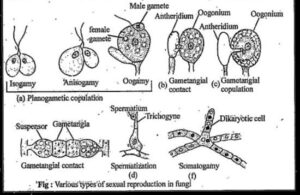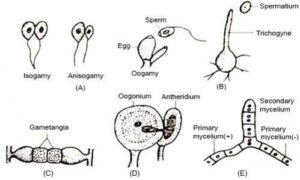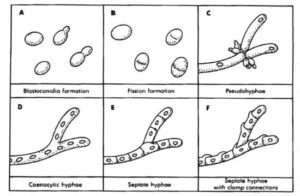Back to: MICROBIOLOGY 300 LEVEL
Welcome to class!
Hello there, superstar! I’m so glad you’re here again, ready to learn and grow. You’re doing so well, and today’s lesson is another exciting one—Morphology and Classification of Fungi. Yes, fungi! You’ve probably seen them before—maybe on stale bread or growing on damp walls. But fungi are so much more than that, and they play important roles in nature, medicine, and even in the food we eat. Let’s walk through this fascinating world together.
Morphology And Classification Of Fungi
Fungi are a unique group of organisms that are neither plants nor animals. They belong to their own kingdom—Kingdom Fungi. You’ve likely come across mushrooms, mould on bread, or even yeast in baking. These are all fungi, and they can be seen with the naked eye or under a microscope, depending on their type.

Unlike plants, fungi do not have chlorophyll, so they don’t make their own food through photosynthesis. Instead, they feed on other materials, often by breaking down dead plants and animals. That’s why fungi are known as decomposers.
Morphology of Fungi
Let’s look at what fungi look like—their structure or morphology. Fungi come in various forms, but many share some common parts:
Hyphae: These are long, thread-like filaments that make up the body of most fungi. They grow and spread to form a network called mycelium.
Imagine hyphae as strands of noodles spreading through soil or bread.
Mycelium: This is the collection of hyphae, and it’s often what you see as fuzzy growth on food. Mycelium is the main feeding structure of the fungus.
Spores: These are tiny reproductive units, like seeds, that help fungi spread. Spores can be carried by wind, water, or animals.
Just like a dandelion spreads its seeds in the wind, fungi release spores to find new places to grow.
Fruiting Body: This is the part you often see above ground, like mushrooms. It produces and releases spores.
Some fungi are unicellular, like yeast, which are tiny and live as single cells. Others, like moulds and mushrooms, are multicellular with well-developed structures.
Classification of Fungi
Fungi are classified based on their structure and how they reproduce. Here are the major groups:

Zygomycota (Zygomycetes)
These fungi produce thick-walled spores called zygospores.
Example: Rhizopus, the common bread mould you may have seen on stale bread.
Ascomycota (Ascomycetes)
Also called sac fungi because they produce spores in sac-like structures called asci.
Examples: Yeast (Saccharomyces) and Penicillium (used in antibiotics).
Basidiomycota (Basidiomycetes)
These fungi produce spores on club-shaped structures called basidia.
Examples: Mushrooms, toadstools, puffballs.
Deuteromycota (Fungi Imperfecti)
Called “imperfect fungi” because their sexual stage of reproduction is not known.
Example: Aspergillus, which can be found on spoiled grains or nuts.

Think about making eba. If you leave the cooked garri out for too long, especially in a damp corner, you may see fuzzy growth on it—that’s likely a mould, a type of fungus. Or when your mum bakes bread and uses yeast to make it rise—that’s fungi helping the dough grow. Even penicillin, a life-saving antibiotic, was discovered from a mould called Penicillium!
Summary
- Fungi are a group of living things different from plants and animals.
- They do not photosynthesise; instead, they feed on organic matter.
- Common structures include hyphae, mycelium, spores, and fruiting bodies.
- They can be unicellular (yeast) or multicellular (moulds, mushrooms).
- Fungi are classified into Zygomycota, Ascomycota, Basidiomycota, and Deuteromycota based on how they reproduce and their structure.
Evaluation
- What are hyphae and mycelium in fungi?
- Give two examples of fungi that belong to Ascomycota.
- Which group of fungi is known for producing mushrooms?
- Why are fungi not considered plants?
- What does yeast do when added to dough?
You’ve done a fantastic job learning about fungi today! From bread moulds to life-saving medicines, fungi are truly amazing—and now you understand why. Keep that mind curious and sharp, because the more you learn, the more powerful your knowledge becomes. At Afrilearn, we’re always here cheering you on. See you in the next exciting lesson!
